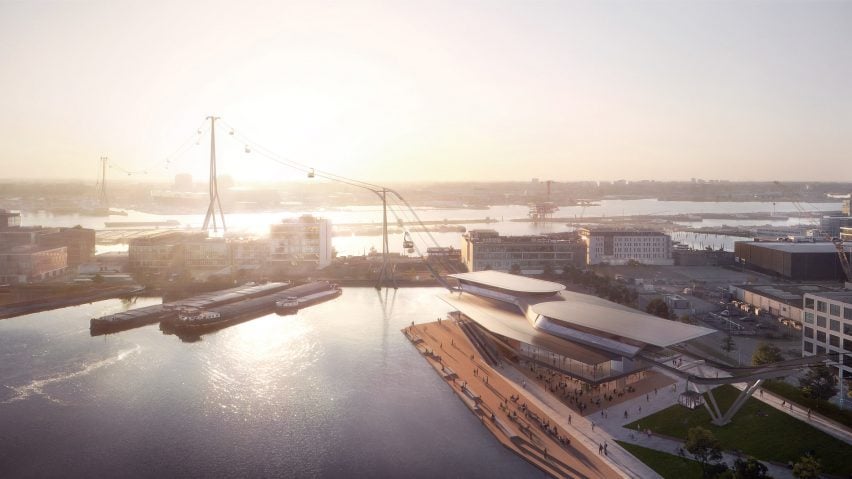Dutch firm UNStudio has revealed designs for a 1,500 metre-long cable car across the across the river IJ in Amsterdam.
The cable car would connect the growing residential areas of Amsterdam-West and Amsterdam-Noord in under five minutes.
Commissioned by the IJbaan Foundation – a grassroots citizen initiative led by Bas Dekker and Willem Wessels – the new connection is intended to be in operation in 2025.
"In Amsterdam you see a growing need for connections across the IJ, with the new metro and bridges," said UNStudio founder Ben van Berkel.
"The city is growing enormously and such an 'air bridge' contributes to the development of the entire region."
The new design follow on from UNStudio's cable car plans for Gothenburg, which were unveiled in February 2018.
Running at an average speed of 13.4 miles per hour (21.6 kilometres per hour) the cable car's cabins could hold up to 37 passengers on the 4.6 minute journey across Amsterdam. Additional bicycle cabins could hold four to six bikes.
The foundation expect the fast connection between the west and the north will positively impact bicycle traffic by connecting existing networks on both sides of the IJ.
"It is a very fast and green way of traveling, which is attractive for cyclists, commuters, students, residents and visitors," continued Ben van Berkel.
"Transport by air also relieves the increasing pressure on traffic and the existing transport network on the ground. It is not only efficient but also fun. People are going to see and experience their city in a whole new way."
Two stations are planned in phase one – NDSM Marina on the north bank and Minervahaven on the south.
With restaurant and bar facilities as well as viewpoints, the stations are not only designed as transport hubs for pedestrians and cyclists, but also "destinations in themselves."
The cable car would be carried on three slender pylons that according to the studio reference the ports and ship cranes of Amsterdam's "robust" industrial past.
The towers vary in height to enable large ships to sail along the IJ, standing at heights of 46 metres and 105 metres tall on either side of the water, with a 136 metre-tall tower standing in the river.
While providing an "enriching" addition to Amsterdam's skyline, the studio believe the new towers adhere to the city's UNESCO World Heritage requirements, and are not visible from the famous canal rings in Amsterdam's city centre.
"The cable car's three slender towers will allow the dense urban area of Amsterdam to expand, while being respectful of the city's past," said the studio.
"The cable car provides an architecturally interesting addition to the city and the harbour view, contributing to the spread of tourism in the city," he added.
UNStudio designed the cable car system flexibly, to allow for route expansion in the future to include a third station that would connect the Hemknoop, Sloterdijk Station or even Westergasfabriek and the Westerpark, depending on growth and need.
The Amsterdam cable car is due to be completed in 2025 to coincide with the city's 750th anniversary. A second phase, which would continue to Hemknoop, is proposed to be completed by 2040.
Along with UNstudio's plans for a cable car in Gothenburg, cable car are being planned and built in cities around the world. In 2016 Marks Barfield and Davis Brody Bond proposed linking Navy Pier to the Riverwalk and Millennium Park in Chicago, while in London, Wilkinson Eyre designed the 1,000 metre long Emirates Air Line cable car over the River Thames.

